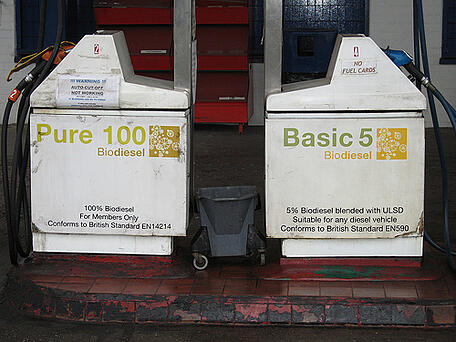 Yesterday I attended a presentation on biofuels by Steven Briggs, a biology professor at University of California, San Diego. Professor Briggs possesses a wealth of academic and industrial experience with genomics and biofuels, including corn ethanol, biodiesel, and algal biodiesel. Undoubtedly, Professor Briggs is an expert in bioenergy, and the overwhelming attendance indicated the importance of the industry to the greater San Diego area. Today I would like to highlight some of the topics Briggs spoke on (underlined, paraphrased).
Yesterday I attended a presentation on biofuels by Steven Briggs, a biology professor at University of California, San Diego. Professor Briggs possesses a wealth of academic and industrial experience with genomics and biofuels, including corn ethanol, biodiesel, and algal biodiesel. Undoubtedly, Professor Briggs is an expert in bioenergy, and the overwhelming attendance indicated the importance of the industry to the greater San Diego area. Today I would like to highlight some of the topics Briggs spoke on (underlined, paraphrased).
Liquid hydrocarbon fuels account for 41% of the energy consumed
Professor Briggs highlighted the tremendous consumption of liquid fuels, primarily oil. Briggs later noted that there is an existing infrastructure for liquid fuels.
What does this mean? Biofuels that are compatible with existing hydrocarbon infrastructure have a tremendous financial advantage. All of the biomass projects I have seen create energy or fuel that fits into existing infrastructure. Ethanol, for instance, has found a market as a replacement for liquid hydrocarbons precisely because it can be used within the existing infrastructure (car engines). As Professor Briggs noted though, ethanol is more corrosive than oil, which has prevented its use in the existing infrastructure that transports oil from refineries to gas stations. Other projects I have seen include converting wastes (biomass) into electrical or steam energy, or into solid fuels for use in cement kilns. The common thread for current projects: Apply renewable fuel sources to existing infrastructure.
Oil production in the United States peaked in 1970. Using theories derived from oil production in the United States, and that of coal production in England, worldwide production of oil is expected to have peaked in 2005. Early estimates indicate that this may be the case.
Has the world hit the downslope of oil production? There are far-ranging impacts to a decrease in oil production, both economic and political. For the biofuels market in particular, it may lead to higher prices for hydrocarbon fuels and more cost-competitiveness, one of, if not the key obstacle that biofuels must overcome. A further sign of a drop in oil production might be in the flurry of activity in biofuel research by traditional hydrocarbon-based companies. Exxon-Mobil, Chevron, and British Petroleum have all made recent announcements of significant investment in biofuels.
The United States has set a target of 24% of all energy consumption from renewable fuels by 2022.
Briggs provided a table with mandates for renewable energy consumption for a number of countries. Briggs was quick to point out that the mix of renewable fuels to meet this target is yet to be determined. Obviously though, consumption will be driven to the lowest cost fuel that meets the definition of renewable fuels. Hydrocarbon liquids have such a huge share of the energy market because they are precisely the lowest cost fuel. We can reasonably expect that the lowest cost renewable energy fuel will corner the market in the same fashion that hydrocarbons have for the past 200 years.
I will have more on the second part of Professor's Briggs presentation, algal biodiesel, in my next post.
For a presentation on ethanol scrubbing, download the presentation below.
Photo Credit: Binary Ape


